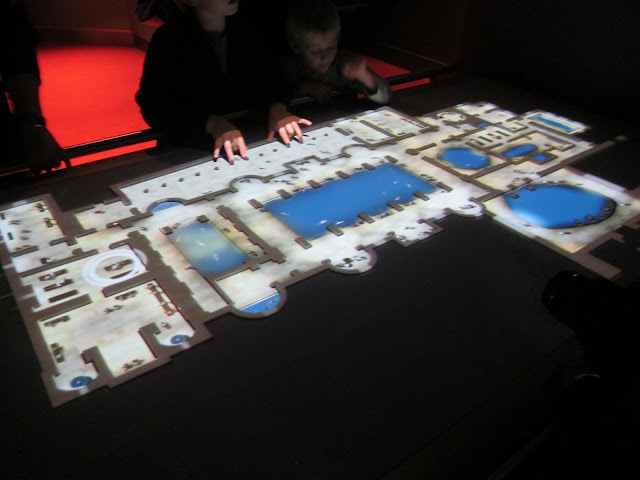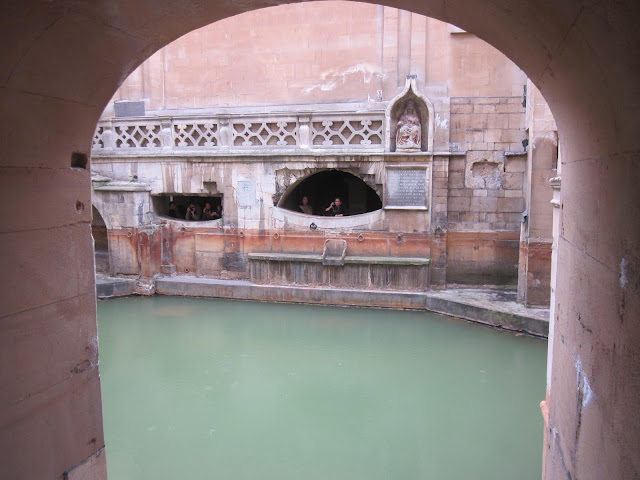Windsor Castle, Stonehenge, & Bath

I took this picture of one of the breweries as we drove out of town. we have yet to tour one.
Windsor Castle is the world's oldest and largest inhabited castle and home to Queen Elizabeth II from Friday to Sunday. The castle has been inhabited since 1068 by King William I (over 900 yrs). It has been added to and restored over the years. The castle is vast and we didn't see but 1/3 of it.
In 1992 there was a fire here started when a lamp was left on next to a curtain. It did a lot of damage and it took 3 1/2 years for the rooms to completely dry. They were able to restore everything but one painting. I was here after the fire in 2009 when some of the rooms were still blocked off.
The round tower holds the state apartments which contains the Royal collection of furniture and paintings including Rubens, Van Dyck, Rembrandt, and many more. The gardens were beautiful even for October. One of the more interesting features of the Castle was Queen Mary's doll house (of an enormous manse). It was built to 1/12 scale in 1924 by Sir Edwin Lutyens. It features running water, electric lamps and many fine details including the mops, vacuum cleaner, tools, fine china, silver, linens, oriental rugs, etc.
Across the court yard is where the Queen resides.
Changing of the guard.
St George's chapel built between 1478-1511. Here is where King Henry VIII is buried next to Jane Seymour. Ten sovereigns are buried here. Here also is where all the crests are for the Order of the Garter. This a very important ceremony that started in 1348 and is the highest order of chivalry of knighthood in England.The ceremony takes place every year in June and this is one of the only personal and executive influences that the Queen truly has. She appoints the 24 knights.
This is Eton College where both Henry and William attended. This is seen from the castle wall.
I never knew that the Queen was quite the horse lady. She was left horses by her mother and is quite active in the race track. This is the only picture that I could get of her horse fields that are used for show and jumping about 4800 acres. During the racing season it is a privilage to be invited to view the races. There is quite strong etiquette set for atendence. Everyone wears a hat and dress with no short sleeves,no pants etc.-men are in top coats with tails. On a side-note the Queen is only #257 richest woman in the world.
Polo was started by Duke of Edinburgh, Phillip and Charles and his sons still carry on the sport.
Stonehenge...a mystery that still remains today. Even the dates aren't the same. But in 2008 with radiocarbon technology they believe the first stones were erected in 2400-2200 BC while there were outer stones that date back to 3100BC and used for cremation as the bones were found here dating to 3000BC. It is believed that there were 3 phases over a span of 1500 years. There are different stones here. The bluestones weigh 6-8 tons and come from 150 miles away from Wales.
There are 30 enormous sarsen stones and "mortise and tenon" stones were placed on top. Each standing stone is about 13 feet high, 6 feet wide, by 3 feet thick and weighs 25 tons.
Inside the circle there are 5 sarsen stones formed in a horseshoe with its opening facing NE. These stones weigh up to 50 tons
 These stones are lined up so on the 21st of June the sun lines up and shines in the middle. The outer stones are the Circle of sarsen stones with lintels. The next row that is lined up is the horseshoe of sarsen trilithons.(the taller one behind) There is also the Bluestones that form a circle within the outer sarsen stones.
These stones are lined up so on the 21st of June the sun lines up and shines in the middle. The outer stones are the Circle of sarsen stones with lintels. The next row that is lined up is the horseshoe of sarsen trilithons.(the taller one behind) There is also the Bluestones that form a circle within the outer sarsen stones.There are 2 groups of stones formations within the outer layer.
This picture points out the outer stone used for slaughter/ crematory stone. and the ditches that are around. They think these are Aubrey holes where timbers were placed (56 of them) just outside the ditch.
This "little"guy is called the station stone which is out side the ditch.
There is a period of time that Stonhenge was left and they don't know why. Last construction at the site is estimated to have taken place around 1600BC. Last usage is thought to be around 700 BC.
The mystery is still there and every day new things are discovered. As for the size of the stones, 1/3 of them are buried underground.
The Blind House. Here is where you went to sober up. There was no light in the Blind House. The term "blind drunk" comes from this use. Another sayings from England were "one for the road" the prisoners were offered one hard drink for the road on their way to their death. The prisoner could get "off the wagon" for this to occur. "On the wagon" indicated the prisoner didn't want the drink.
The old thatched roof.
Here we are arriving in Bath at the Roman baths. Looking at the Bath Abby with the bath house to the right.
A model of how the baths looked back in the time. The brown area is showing the opening to the main baths. It had a roof over it then but as you will see it is gone today.
The large rectangular blue is the main bath and the bigger round area is a cold water pool. the little ones are hot baths like steam baths, hot tubes with built in seats. These baths were established here due to the natural hot springs located in Bath. These hot springs still produce hot sulfuric water today.
This the main bath with no roof.
The other end looking towards the Abby.
The cold water pool which is called the Sacred Spring.
Another picture of the scared spring.
Blocks under the floor for heating the tiles in the bath house. Hot air is circulated around the pillars and then escapes through hollow flue tiles built into the wall .
It is amazing how much is still intact. Another interesting fact is that the lead lining the pools is original with a thickness of about 3/4 inch. There are no leaks 2000 years later!
City of Bath down town.
When we were leaving we took a little detour to see the upper scale housing [second homes] for Londoners. This is a large circular structure built on a cul-de-sac. Bath is built on top of a hill and you just keep going up!!
 The beautiful country side going back to London.
The beautiful country side going back to London.It was a long 11 hours but well worth the trip. Tomorrow will be my last day of London. Cheerio :-)



























No comments:
Post a Comment